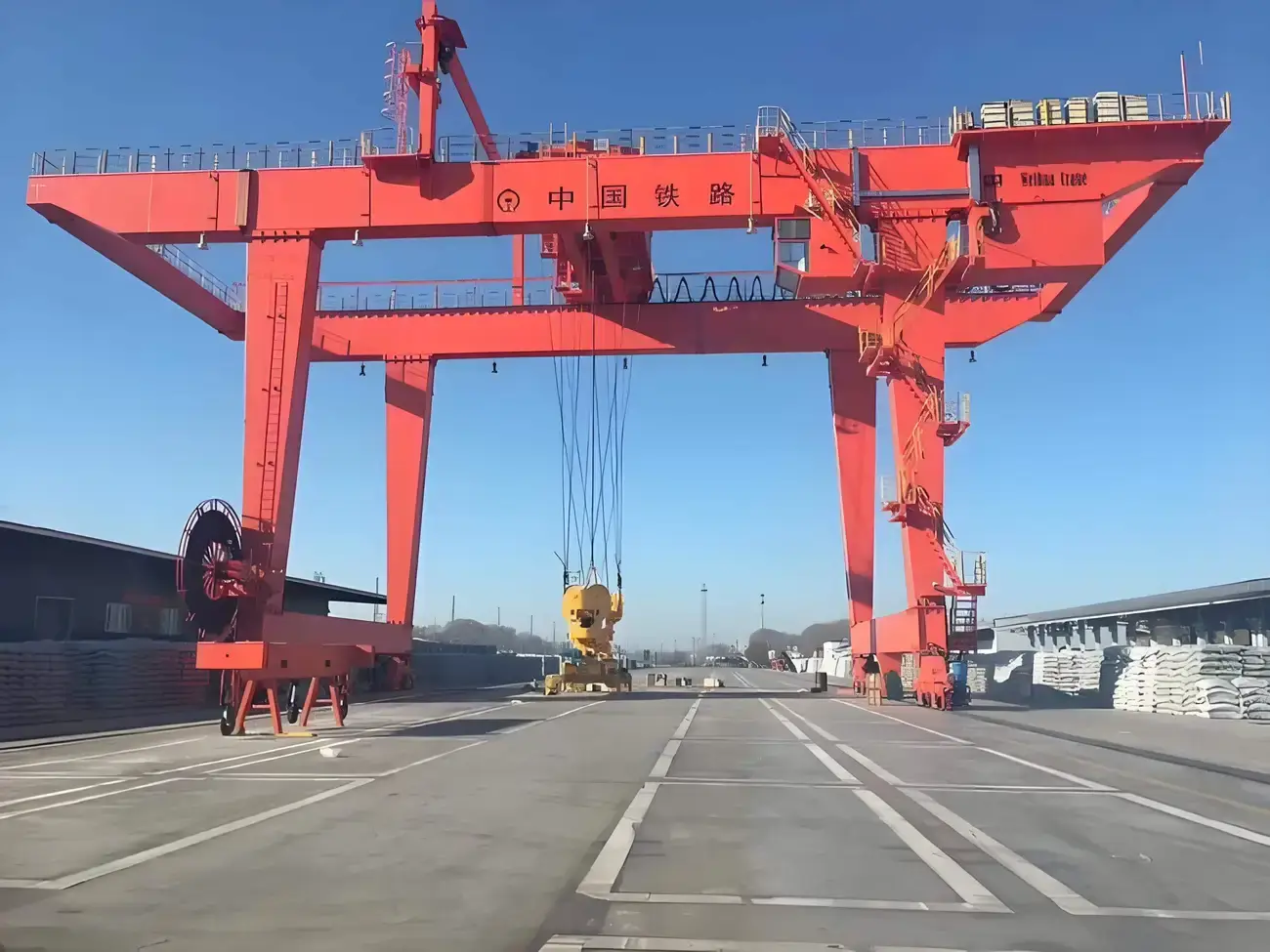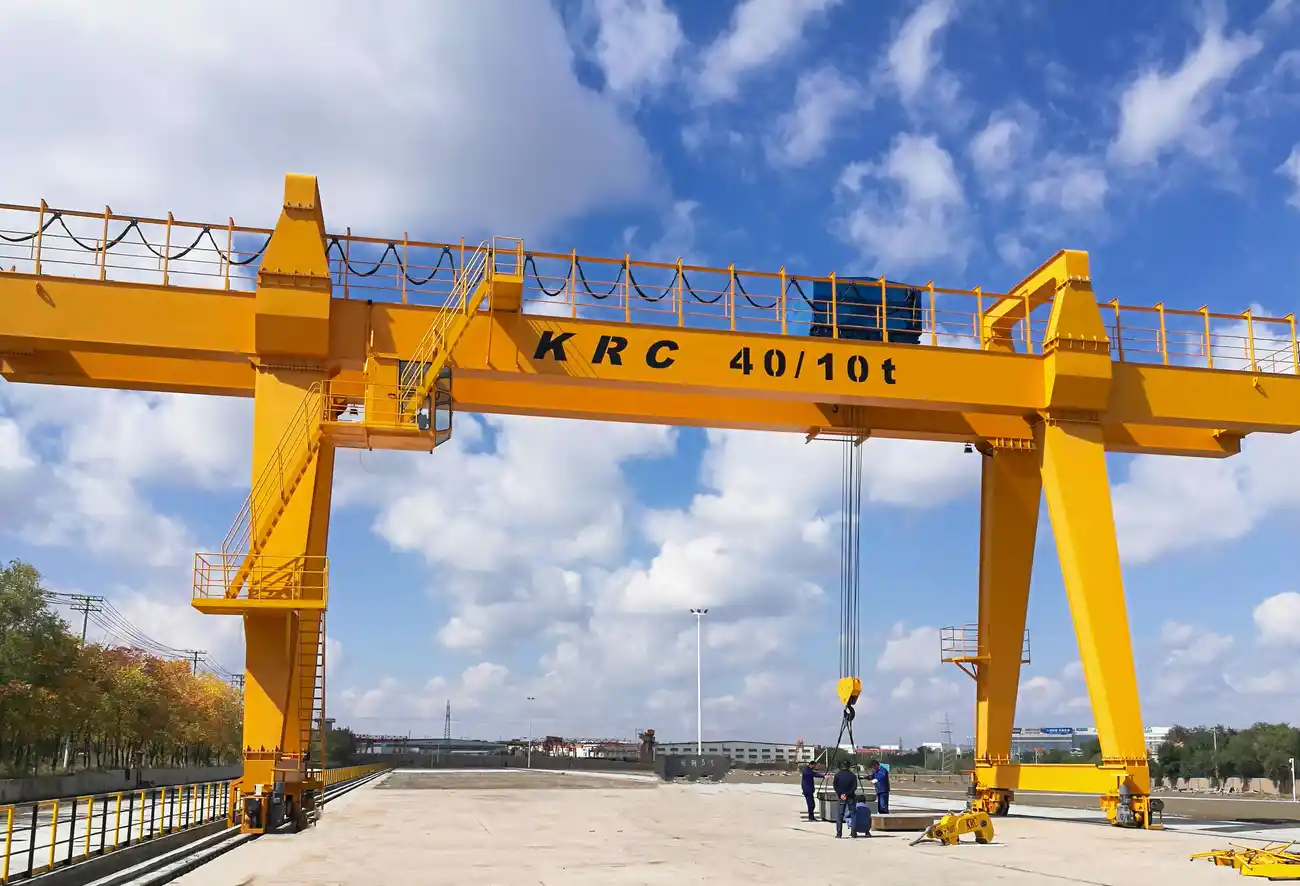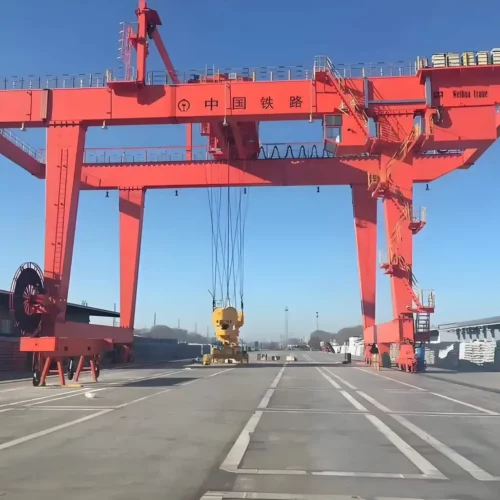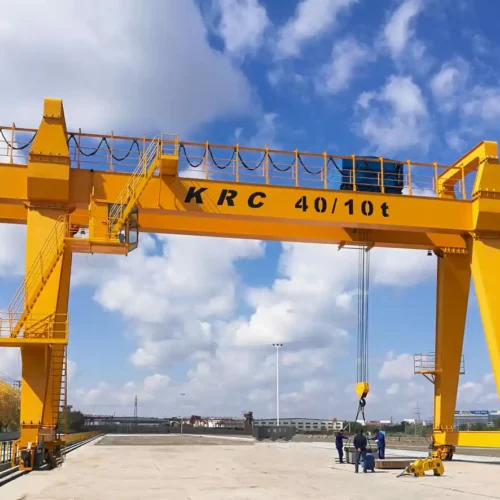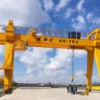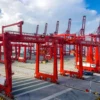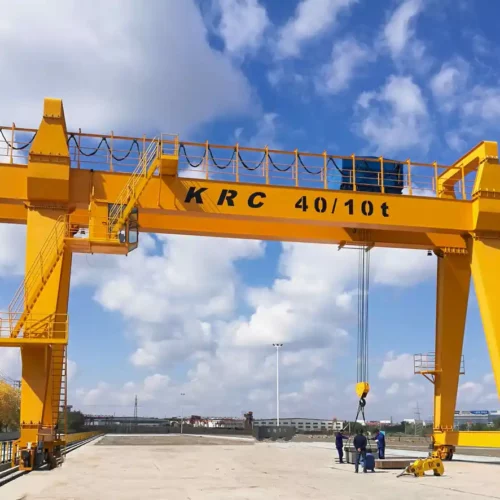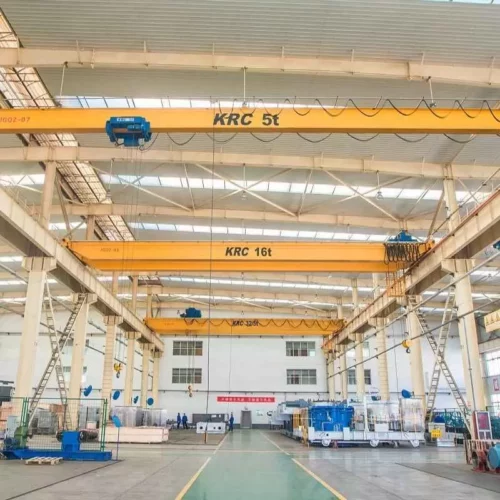rail mounted container gantry crane Safety Certifications
Rail Mounted Container Gantry Cranes (RMG cranes) are subjected to rigorous safety standards and certifications to ensure their safe and efficient operation. Here are some of the key safety certifications often required for these cranes:
1. ISO Certifications:
– ISO 9001: Ensures Quality Management Systems (QMS) are in place to meet customer and regulatory requirements.
– ISO 14001: Pertains to Environmental Management Systems, ensuring that the crane’s manufacturing process minimizes environmental impact.
– ISO 45001: Focuses on Occupational Health and Safety Management Systems for worker safety.
2. European CE Marking: Indicates conformity with health, safety, and environmental protection standards for products sold within the European Economic Area.
3. OSHA (Occupational Safety and Health Administration): Regulations in the United States that ensure safe and healthful working conditions.
4. ANSI Standards: The American National Standards Institute provides standards on safety, including crane operation and maintenance (e.g., ANSI/ASME B30 series).
5. FEM Standards: The European Federation of Materials Handling provides comprehensive guidelines on mechanical design, electrical equipment, and safety protocols.
6. Lloyd’s Register: Offers certification for the design, construction, and installation of cranes to ensure that they meet international safety standards.
7. DNV GL Certification: Provides risk management and quality assurance services for cranes, including verification of safety features and engineering practices.
8. DIN Standards: German standards (Deutsches Institut für Normung) that ensure high levels of safety and reliability in mechanical engineering.
9. EN Standards (Europe): The European Norms (e.g., EN 13001) specify requirements for safe crane design and operation.
These certifications are critical for minimizing risks and ensuring that RMG cranes can be operated safely and efficiently in port and intermodal terminal environments. Regular inspections, maintenance, and operator training also play crucial roles in upholding safety standards.
List Reference Technical Parameters of “rail mounted container gantry crane”
Rail mounted container gantry cranes (RMG cranes) are critical pieces of equipment in container terminal operations, known for their efficiency, reliability, and capacity to handle heavy loads. Here are some key technical parameters:
1. Lifting Capacity: Generally ranges from 20 to 65 tons, depending on the specific design and application.
2. Span: The span, which is the distance between the rails, usually varies from 20 to 50 meters.
3. Hoisting Height: Typically ranges from 15 to 40 meters, enabling the crane to stack containers several tiers high.
4. Trolley Travel Speed: Generally between 20 to 70 meters per minute, affecting the efficiency of horizontal container movement.
5. Hoisting Speed: Usually varies from 10 to 50 meters per minute, depending on whether the load is full or empty.
6. Crane Travel Speed: Typically around 20 to 45 meters per minute, facilitating the movement of the crane along the rails.
7. Span Number: Can be single, double, or multiple spans, affecting the design and placement of the crane.
8. Power Supply: Mainly electric, usually via a cable reel or conductor bar system, ensuring steady and reliable operation.
9. Control System: Advances include options for manual, semi-automated, and fully automated control systems, often incorporating features like anti-sway and load positioning systems.
10. Wind Load Resistance: Designed to withstand strong winds, often around 25 to 50 m/s (meters per second), ensuring safety and stability even in harsh weather conditions.
11. Operating Temperature Range: Engineered to function efficiently within a broad temperature range, typically from -20°C to +40°C.
12. Wheel Load: The maximum load each wheel can support, generally varying between 10 to 30 tons, crucial for track and infrastructure design.
These parameters of rail mounted container gantry cranes underscore their capability to handle diverse operational needs in container terminals, enhancing logistical efficiency and throughput.
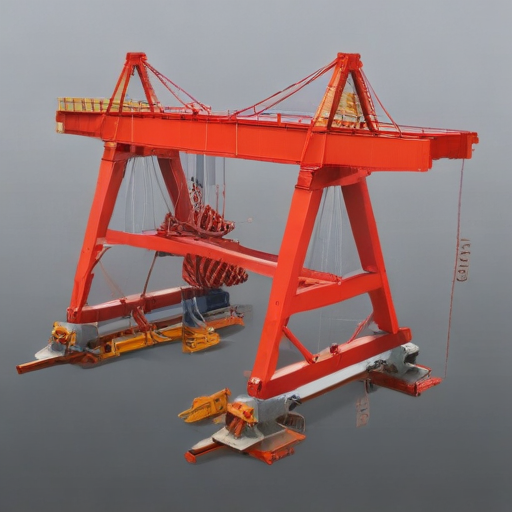
List Product features of “rail mounted container gantry crane”
Product Features of Rail Mounted Container Gantry Crane
1. High Lifting Capacity: Supports heavy-duty lifting with capacities typically ranging from 35 to 65 tons.
2. Precision Control: Advanced control systems for precise positioning and handling of containers, reducing the risk of damage.
3. Efficiency: Capable of handling a high volume of containers, optimizing terminal operations and throughput.
4. Stability: Designed with a robust steel structure that ensures stability and longevity under heavy loads and harsh conditions.
5. Span and Height: Flexible span and height options to accommodate diverse operational needs, catering to different types of vessels and yard layouts.
6. Automation and Remote Operation: Options for semi-automatic or fully automated operations, often equipped with remote control capabilities.
7. Energy Efficiency: Engines and drive systems are engineered for energy efficiency, reducing operational costs and environmental impact.
8. Safety Systems: Equipped with comprehensive safety features, including anti-sway systems, overload protection, and emergency stop functions.
9. Anti-Collision Technology: Advanced sensors and anti-collision systems to avoid accidents, ensuring safe and smooth operations.
10. Weather Resistance: Built to withstand harsh weather conditions, including heavy winds and rain, with corrosion-resistant materials.
11. Maintenance and Diagnostics: Easy-to-access components for routine maintenance, along with integrated diagnostic systems to monitor equipment health and preemptively identify issues.
12. Modular Design: Allows for modular extensions and upgrades, providing scalability as per evolving operational requirements.
13. Operator Comfort: Ergonomically designed cabins with climate control and panoramic views for operator comfort and efficiency.
14. Environmental Compliance: Complies with international environmental and safety standards, ensuring minimal ecological impact.
15. Customization: Can be tailored to specific operational needs, with various configurations and optional accessories available.
16. Intermodal Capability: Compatible with various modes of container transport, including ship, truck, and rail, ensuring seamless integration in logistics chains.
Optimizing terminal operations with precision, efficiency, and reliability, rail mounted container gantry cranes are integral to modern container handling and logistics solutions.
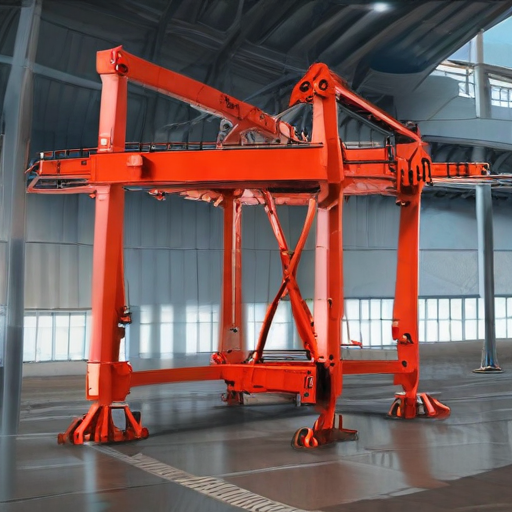
List Various Types of “rail mounted container gantry crane”
Rail Mounted Container Gantry Cranes (RMGs) are specialized cranes for handling containers in intermodal yards, ports, and container terminals. Here are some various types:
1. Single Girder RMG:
– Design: Features a single main girder.
– Use: Suitable for lighter to medium-duty applications.
– Advantages: Lower cost and simpler design.
2. Double Girder RMG:
– Design: Consists of two main girders for enhanced strength.
– Use: Ideal for heavy-duty applications and larger spans.
– Advantages: Higher lifting capacity and greater stability.
3. High-Profile RMG:
– Design: Taller cranes that allow for higher stacking heights.
– Use: Ports and terminals with high storage demands.
– Advantages: Maximizes vertical space and stacking efficiency.
4. Low-Profile RMG:
– Design: Lower height suitable for areas with height restrictions.
– Use: Urban areas or facilities with overhead obstructions.
– Advantages: Prevents conflicts with existing infrastructure.
5. Cantilever RMG:
– Design: Features extended beams (cantilevers) on one or both sides.
– Use: Increased operational range allowing loading/unloading outside the rail tracks.
– Advantages: Greater flexibility in container handling.
6. Full-span RMG:
– Design: Spans the entire storage area with rail tracks situated outside the area.
– Use: Large container yards where space utilization is paramount.
– Advantages: Efficient container storage and retrieval.
7. Semi-RMG:
– Design: One side runs on rails, while the other side uses rubber tires.
– Use: Versatile applications combining rail efficiency with tire flexibility.
– Advantages: Suitable for uneven ground and reduces rail installation costs.
Each type of RMG is designed to meet specific operational needs, balancing factors like lifting capacity, span, height, and flexibility. They play a crucial role in modern logistics, enhancing the efficiency and capacity of container handling operations.
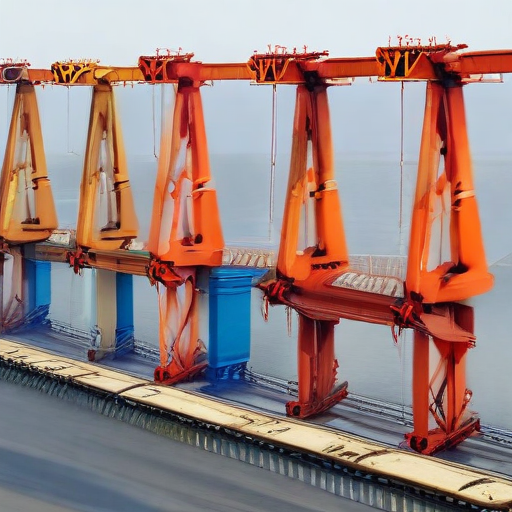
List Application of “rail mounted container gantry crane”
Rail-mounted container gantry cranes (RMG cranes) are essential equipment in various industries due to their efficiency, precision, and heavy lifting capabilities. Here are key applications:
1. Container Terminals: RMG cranes are vital in seaports and inland container terminals for stacking and moving shipping containers. They maximize space and improve loading/unloading times.
2. Rail Yards: These cranes are used in intermodal terminals to transfer containers between trains and trucks, optimizing cargo flow and reducing turnaround times.
3. Warehousing and Distribution Centers: RMG cranes aid in the storage and retrieval of containers in large warehouses, enhancing inventory management and space utilization.
4. Manufacturing Plants: In heavy manufacturing, these cranes handle large components and machinery, facilitating efficient production processes.
5. Steel Yards: RMG cranes transport heavy loads like steel coils and bars within steel plants, contributing to efficient material handling.
6. Power Plants: They are used in power plants for handling heavy equipment and bulk materials, ensuring smooth operational logistics.
7. Shipbuilding Yards: In shipyards, these cranes move large structural components and modules, supporting vessel construction and repair activities.
8. Mining and Bulk Material Handling: RMG cranes are employed in mining operations for handling ore, coal, and other bulk materials, improving operational efficiency.
9. Construction Sites: These cranes lift and place heavy construction materials, aiding in large-scale construction projects.
10. Logistics Hubs: RMG cranes streamline operations in logistics hubs by facilitating the quick transfer of goods between different transportation modes.
RMG cranes enhance productivity, reduce labor costs, and improve safety across these diverse applications, making them indispensable in modern industrial operations.
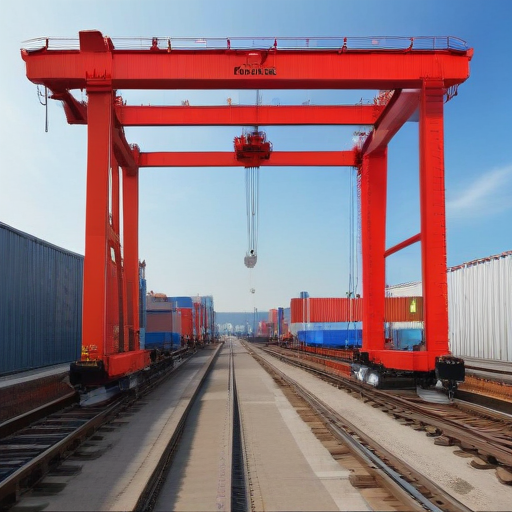
List Buyer Types of “rail mounted container gantry crane”
Sure, here are some common buyer types for rail mounted container gantry cranes (RMG cranes):
1. Port Authorities: These organizations manage seaports and are responsible for infrastructure, including container handling equipment. They invest in RMG cranes to improve efficiency and capacity in container terminals.
2. Logistics Companies: Firms specializing in logistics and supply chain management often purchase RMG cranes to enhance their container handling capabilities, particularly in large distribution centers or inland container terminals.
3. Shipping Companies: Large shipping corporations that own and operate terminals in strategic locations around the globe may invest in RMG cranes to streamline operations and reduce turnaround times for their vessels.
4. Rail Companies: Rail operators that run intermodal terminals or inland depots use RMG cranes to transfer containers between trains and trucks, facilitating seamless multimodal transport solutions.
5. Container Terminal Operators: Independent or subsidiary firms that run container terminals within ports and intermodal facilities may purchase RMG cranes to keep up with demand and modernize their infrastructure.
6. Government Agencies: Various government bodies involved in trade facilitation, infrastructure development, and economic growth may fund and procure RMG cranes for national or regional ports and terminals.
7. Third-party Logistics Providers (3PL): These companies manage supply chain operations for various clients and could use RMG cranes in their facilities to offer efficient container handling services.
8. Industrial Enterprises: Large manufacturing or commercial enterprises requiring extensive container handling capabilities for raw materials and finished goods may also invest in RMG cranes to optimize their internal logistics.
Each of these buyer types aims to enhance their operational efficiency, throughput, and competitiveness through the strategic deployment of rail-mounted container gantry cranes.
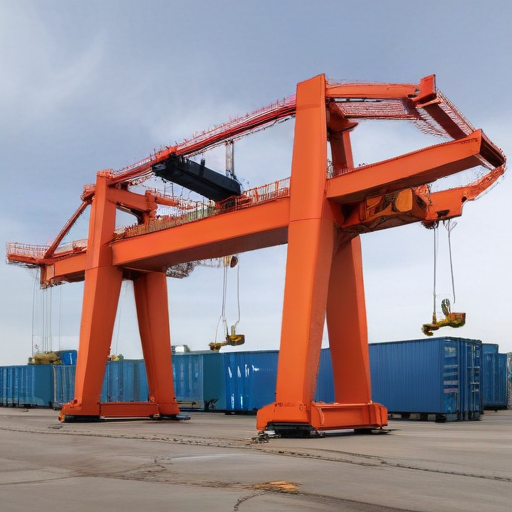
List “rail mounted container gantry crane” Project Types for Different Industries
Rail-mounted container gantry cranes (RMGs) are versatile and highly efficient for handling containers in various industries. Here are the primary project types that utilize these cranes:
1. Port and Terminal Operations:
– Container Terminals: RMGs are essential for loading and unloading shipping containers from vessels to rail cars or yard storage, optimizing container movement and storage.
– Bulk Cargo Handling: While primarily used for containerized cargo, RMGs can be adapted for handling bulk commodities in specialized port terminals.
2. Intermodal Rail Yards:
– Rail-Served Warehousing: RMGs streamline the transfer of containers between railcars and warehouses, facilitating efficient logistics and storage solutions.
– Freight Depots: They enable swift container transfers between road and rail transport, improving throughput in freight distribution hubs.
3. Freight and Logistics Centers:
– Distribution Centers: RMGs enhance container handling efficiency within large distribution centers, supporting swift dispatch and receipt of goods.
– Transshipment Hubs: They play a pivotal role in the intermediate storage and distribution of goods, aligning multimodal transport solutions.
4. Manufacturing and Industrial Plants:
– Raw Material Handling: Industries like steel, automotive, and chemical sectors use RMGs to manage raw materials and finished goods more efficiently.
5. Inland Container Depots (ICDs):
– Cargo Storage: RMGs facilitate high-density container stacking and retrieval in inland depots, optimizing the use of space and improving operational efficiency.
– Customs Bonded Warehouses: They assist in efficient handling and inspection of imported and exported goods stored under customs control.
6. Logistics Parks:
– Integrated Logistics Centers: RMGs support seamless intermodal operations, streamlining container movement within comprehensive logistics parks comprising warehousing, freight forwarding, and transport services.
These project types demonstrate the adaptability and indispensability of rail-mounted container gantry cranes in enhancing the efficiency of container handling across diverse sectors.
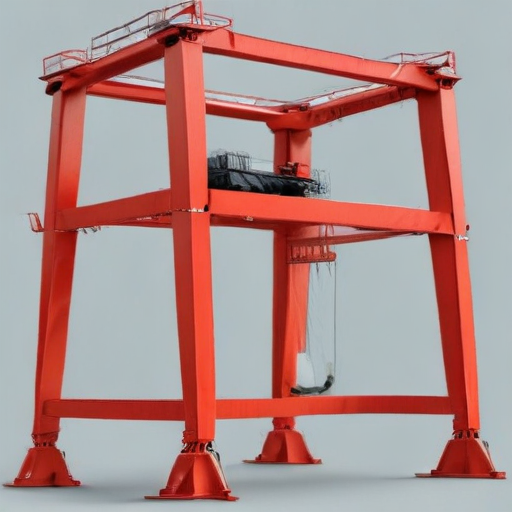
rail mounted container gantry crane Accessories Upgrades and Custom Manufacturing Options
Rail-mounted container gantry cranes are essential for efficient container handling in ports and intermodal facilities. To optimize their performance, various accessories, upgrades, and custom manufacturing options are available.
Accessories:
1. Spreader Beams: Customizable for different container sizes and equipped with advanced sensors for precise handling.
2. Anti-sway Systems: Incorporating sensors and control systems to minimize load sway, ensuring accurate placement and increased safety.
3. Remote Control Systems: Allowing operators to control the crane from a distance, enhancing safety and operational efficiency.
4. CCTV Systems: For improved visibility and monitoring, aiding in safer and more precise operations.
5. Lighting Solutions: High-intensity LED lights to ensure better visibility during night operations and adverse weather conditions.
Upgrades:
1. Automation Upgrades: Adding semi or fully automated systems to improve efficiency and reduce the need for manual intervention.
2. Software Enhancements: Integrating advanced software for better task planning, fleet management, and predictive maintenance.
3. Energy-efficient Drives: Implementing variable frequency drives to reduce energy consumption and enhance operational control.
4. Load Monitoring Systems: Real-time load monitoring to prevent overloading and ensure the longevity of the crane.
5. Eco-friendly Technologies: Incorporating renewable energy sources, like solar panels, and using greener materials to reduce environmental impact.
Custom Manufacturing Options:
1. Tailored Designs: Custom crane dimensions and configurations to suit specific operational requirements and facility constraints.
2. Material Choices: Options for using high-strength, lightweight materials to improve durability and performance.
3. Special Coatings: Anti-corrosion and wear-resistant coatings for extended lifespan, especially in harsh environmental conditions.
4. Enhanced Safety Features: Customizable safety interlocks, emergency stop systems, and fail-safes to meet stringent safety standards.
5. Integration Capabilities: Ensuring seamless integration with existing port infrastructure and logistics software for streamlined operations.
Incorporating these options can significantly boost the performance, safety, and longevity of rail-mounted container gantry cranes, tailored to meet the evolving demands of the shipping industry.
List Quality Control and The Manufacturing Process of “rail mounted container gantry crane”
Quality Control of Rail Mounted Container Gantry Crane
1. Material Verification:
– Ensure raw materials meet the required standards.
– Test for material properties like tensile strength, durability, and corrosion resistance.
2. Component Inspection:
– Inspect fabricated components for consistency with design specifications.
– Use non-destructive testing (NDT) methods such as ultrasonic and radiographic tests.
3. Welding Quality:
– Verify weld quality through visual inspections and NDT methods.
– Ensure adherence to welding procedures and qualifications.
4. Dimensional Accuracy:
– Employ measuring instruments and tools to check dimensions.
– Conduct alignment and tolerance checks.
5. Assembly Verification:
– Inspect assembly for correct configuration and fitment.
– Test mechanical movements and load operations under simulated conditions.
6. Electrical Systems:
– Check wiring and electrical components for proper installation.
– Perform tests for functionality and safety compliance, such as grounding and insulation resistance.
7. Load Testing:
– Conduct static and dynamic load tests to verify load capacity and structural integrity.
– Ensure the system performs under various load conditions without failure.
8. Final Inspection:
– Review all inspection and test reports.
– Confirm that the crane meets all regulatory and client-specific requirements.
Manufacturing Process of Rail Mounted Container Gantry Crane
1. Design and Planning:
– Develop detailed design specifications and engineering drawings.
– Create a project timeline and resource allocation plan.
2. Material Procurement:
– Source high-quality raw materials like steel, electrical components, and hydraulic systems.
– Perform quality checks on received materials.
3. Fabrication:
– Cut, shape, and weld steel components according to design specifications.
– Use CNC machines for precision cutting and drilling.
4. Component Assembly:
– Assemble the primary structure, including girders, legs, and crossbeams.
– Install the hoisting mechanism, trolleys, and wheels.
5. Electrical and Control Systems:
– Install electrical wiring and components.
– Integrate control systems, including PLCs and remote operation interfaces.
6. Testing and Calibration:
– Perform initial mechanical and electrical tests in the factory.
– Calibrate sensors, controllers, and safety systems.
7. Surface Treatment and Painting:
– Apply anti-corrosive treatments.
– Paint the structure with durable, weather-resistant coatings.
8. Final Assembly and Inspection:
– Conduct a thorough inspection once the crane is fully assembled.
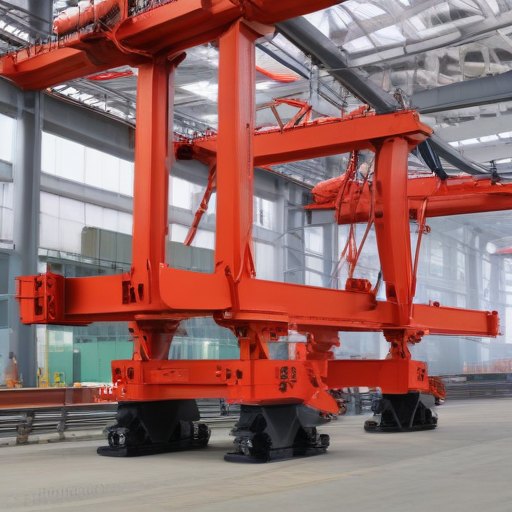
How to use “rail mounted container gantry crane”
A Rail Mounted Container Gantry Crane (RMG) is a type of large overhead crane primarily used for loading, unloading, and moving shipping containers in rail yards, ports, and container storage facilities. Here’s a concise guide to using an RMG:
1. Safety Checks: Begin by conducting a thorough inspection of the crane, including structural integrity, rail conditions, and operational controls. Verify emergency stop functions and ensure that all alarms and warnings are operational.
2. Operator Training: Only certified and trained operators should handle the RMG. Be familiar with the control panel, levers, and software interfaces that manage crane movements and load handling.
3. Load Assessment: Evaluate the container’s weight and dimensions. Ensure that the load is within the crane’s capacity limits. If necessary, consult weight distribution charts.
4. Positioning the Crane: Use the control panel to move the gantry along its rails to the desired location. Align the crane directly above the container to ensure accurate lifting.
5. Spreader Control: Lower the spreader bar using the hoisting mechanism. The spreader bar should securely lock onto the container’s corner castings.
6. Lifting the Container: Gradually lift the container, ensuring it is balanced and does not swing. Maintain a steady, controlled ascent to avoid any damage or instability.
7. Horizontal Movement: Once the container is elevated, move the crane along its rail tracks to the destination, either for loading onto a transport vehicle or for stacking within the storage yard.
8. Lowering the Container: Gradually lower the container to its designated place. Ensure that the landing area is clear of obstructions and personnel.
9. Release and Secure: Disengage the spreader bar from the container corners carefully. Double-check that the container is securely placed and stable.
10. Shut Down: After operations, park the crane in its designated area, perform shut-down procedures, and secure the crane to prevent unauthorized use.
Following these steps will ensure safe and efficient operation of the rail-mounted container gantry crane.
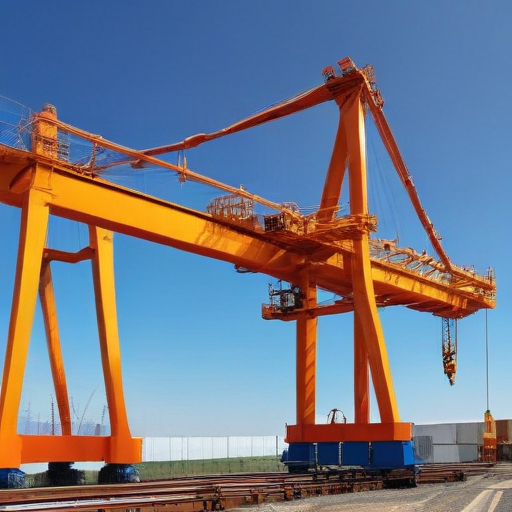
“rail mounted container gantry crane” Comparative Analysis
A Rail Mounted Container Gantry Crane (RMG) is essential in intermodal yards, rail terminals, and container ports for handling cargo containers. This analysis covers key aspects such as efficiency, operational costs, versatility, and environmental impact.
Efficiency: RMG cranes provide high-speed, efficient container handling, often operating 24/7. They feature advanced automation technologies for precise container movement, minimizing human error and enhancing throughput. Compared to rubber-tired gantry (RTG) cranes, RMGs are faster in fixed rail environments but less flexible in operational mobility.
Operational Costs: Initial investment for RMG cranes is higher due to infrastructure requirements, including rail tracks and electrical systems. However, over time, they offer lower operating costs compared to RTGs, as they are powered by electricity rather than diesel, reducing fuel costs and maintenance associated with mobile components. The higher upfront cost is often offset by long-term savings.
Versatility: While RMG cranes excel in structured environments such as rail yards and port terminals with well-defined layouts, they lack the flexibility of RTG cranes in reconfiguring spaces or adapting to different terminal layouts. This limits their use in dynamic environments where container stacking and yard layout change frequently.
Environmental Impact: RMG cranes are more environmentally friendly due to their electric power usage, resulting in lower greenhouse gas emissions compared to diesel-powered RTGs. Their energy efficiency aligns well with green port initiatives aiming at reducing the carbon footprint of port operations.
Conclusion: Rail Mounted Container Gantry Cranes are highly efficient for fixed rail systems, offering significant long-term operational cost savings and environmental benefits. Their primary limitation lies in their lack of flexibility, which makes them ideal for static, high-volume operations but less suited for terminals requiring frequent layout adjustments.
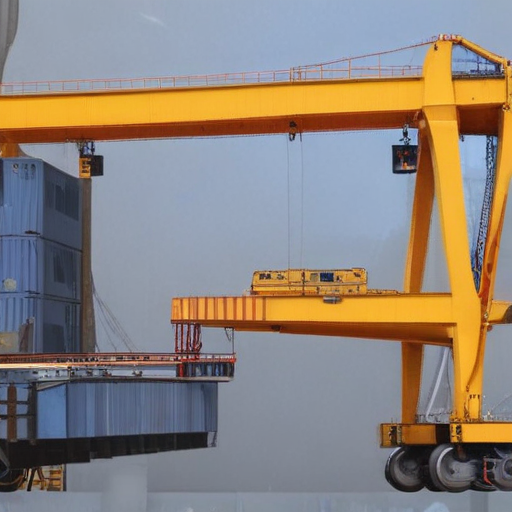
“rail mounted container gantry crane” Warranty and Support
Warranty and Support for Rail Mounted Container Gantry Crane
Warranty:
Our rail mounted container gantry cranes are backed by a comprehensive warranty to ensure your investment is protected. The standard warranty period is typically one year from the date of installation or 18 months from the date of shipment, whichever comes first. This warranty covers any defects in materials or workmanship under normal use and service conditions. It includes full support for parts, labor, and any necessary repairs or replacements. Extended warranty options are available upon request, offering additional peace of mind and prolonged protection against unexpected issues.
Support:
We provide robust support services to maximize the efficiency and longevity of your crane. Our support includes:
1. Technical Assistance: Our team of skilled engineers and technicians is available 24/7 to offer expert technical assistance and troubleshoot any operational issues. They can be reached via phone, email, or remote diagnostics.
2. Onsite Services: Should you need onsite support, our field service technicians are ready to be dispatched promptly. They are equipped to handle inspections, preventive maintenance, repairs, and equipment upgrades.
3. Spare Parts: We maintain a comprehensive inventory of spare parts to minimize downtime. These parts can be shipped quickly to ensure that your operations continue smoothly.
4. Training: We offer thorough training programs for your personnel, covering operations, safety protocols, routine maintenance, and troubleshooting techniques.
5. Software Support: For cranes equipped with advanced software systems, we provide continuous updates and technical support to ensure optimal performance and security.
6. Maintenance Contracts: Tailored maintenance contracts are available to suit your operational needs, including periodic inspections, preventive maintenance schedules, and emergency repair services.
With our extensive warranty and dedicated support services, you can be assured of reliable performance and extended lifespan of your rail mounted container gantry crane.
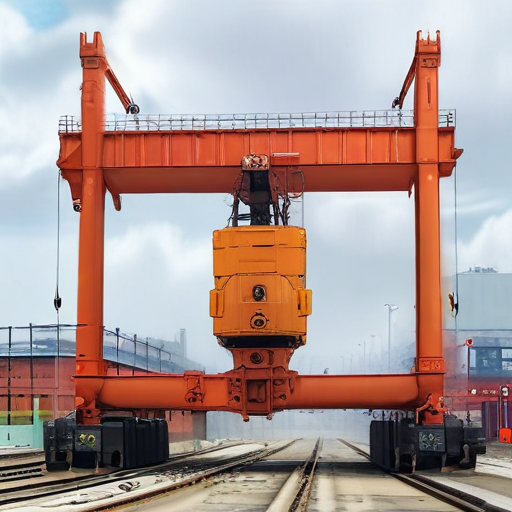
List “rail mounted container gantry crane” FAQ
Rail Mounted Container Gantry Crane FAQ
1. What is a Rail Mounted Container Gantry Crane?
A rail mounted container gantry crane (RMG) is a type of crane used for loading, unloading, and moving containers at ports, rail yards, and storage facilities. It operates on fixed rails and features a large frame that spans the storage area.
2. What are the main components?
The primary components include the gantry structure, trolley and hoisting mechanism, power supply system, control system, and rails.
3. How does it operate?
The crane moves along the rails to position itself over containers. The trolley, carrying the hoisting mechanism, travels horizontally across the gantry to lift and transfer containers.
4. What are the key advantages of RMG cranes?
– High efficiency in container handling
– Reduced labor costs due to automation options
– Stability and precision due to guided rail movement
– Low environmental impact when electrically powered
5. What different types of RMG cranes are available?
Variations include single-girder and double-girder designs, with differences in lifting capacities, rail spans, and automation levels.
6. What are typical applications?
RMG cranes are predominantly used in container terminals, port facilities, inland rail yards, and container storage areas.
7. What is the lifting capacity?
Lifting capacities typically range from 30 to 65 tons, accommodating various container sizes and weights.
8. How are they powered?
Most RMG cranes are electrically powered, using power rails along their tracks.
9. What are the maintenance requirements?
Regular inspections, lubrication of moving parts, electrical system checks, and timely replacement of worn components are necessary for optimal performance.
10. Are they customizable?
Yes, RMG cranes can be tailored to specific operational needs, including custom rail spans, lifting capacities, and automation features.
11. What are safety features?
Common safety features include anti-collision systems, load limiters, emergency stop mechanisms, and automated monitoring.
Understanding these key aspects helps in selecting, operating, and maintaining a rail mounted container gantry crane effectively.
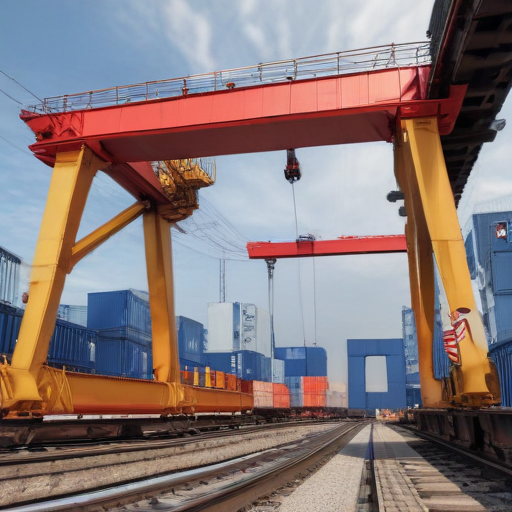
Top 10 FAQ with answer about rail mounted container gantry crane for Buyer Sourcing from China
Certainly! Below are the top 10 frequently asked questions (FAQ) about sourcing rail-mounted container gantry cranes from China. These should give you a comprehensive understanding of what you need to know:
1. What is a Rail-Mounted Container Gantry Crane?
A rail-mounted container gantry crane (RMG) is a type of heavy-duty crane used primarily in container terminals for loading, unloading, and stacking containers. They move on rails and are efficient for handling large volumes of containers.
2. What are the Key Specifications to Consider?
Key specifications include:
– Lifting capacity
– Span length
– Lifting height
– Rail gauge
– Trolley speed
– Hoisting speed
3. What is the Average Lead Time for Manufacturing?
Lead times can vary, but typically, it takes about 5 to 8 months from order confirmation to delivery, depending on the manufacturer and the complexity of the crane.
4. Are Custom Designs Available?
Yes, many Chinese manufacturers offer custom design options to meet specific operational needs and site constraints.
5. What are the Quality Standards Followed?
Chinese manufacturers often adhere to international standards such as ISO, FEM, and IEC. Additionally, they may comply with specific European or American certifications if required.
6. What is the Typical Cost Range?
The cost of an RMG crane can vary widely based on specifications but typically ranges from $1.5 million to $5 million.
7. Are Financing Options Available?
Some Chinese manufacturers offer financing options or can recommend financial partners. Terms and conditions vary, so it’s best to discuss this directly with the manufacturer.
8. What About After-Sales Support?
Most reputable manufacturers offer comprehensive after-sales support, including remote assistance, spare parts supply, and on-site maintenance services.
9. How is Shipping and Installation Handled?
Manufacturers usually handle shipping to the nearest port and can manage on-site installation. This is often included in the overall contract cost, but confirm specifics beforehand.
10. What Warranties are Provided?
Standard warranty periods range from 12 to 24 months, covering parts and labor. Extended warranties may be available for an additional cost.
When sourcing an RMG crane from China, it’s essential to do thorough research, verify certifications, and understand the full scope of what is included in your purchase agreement.

